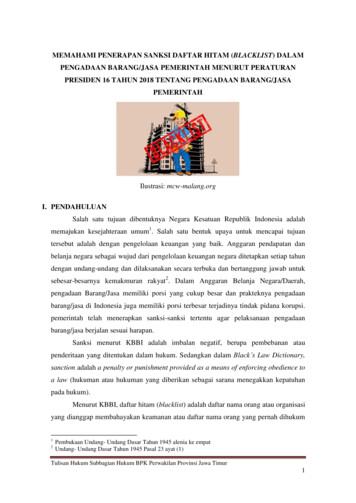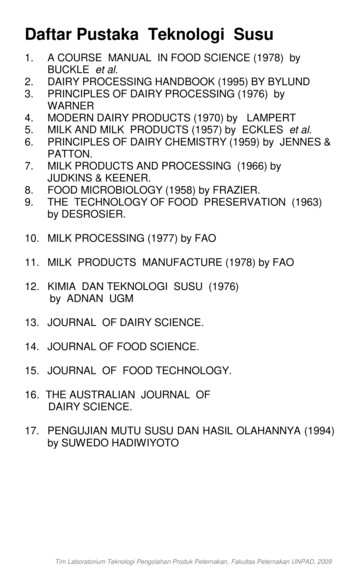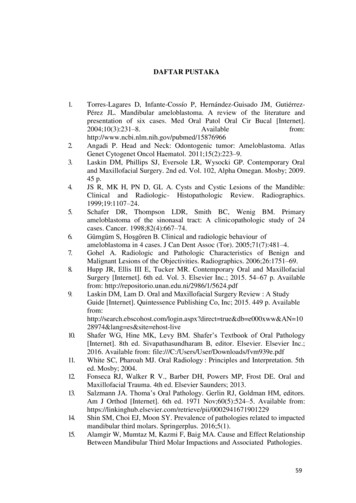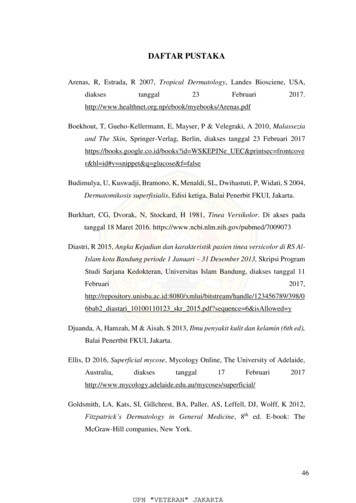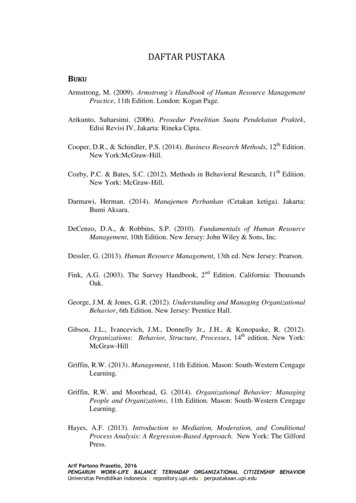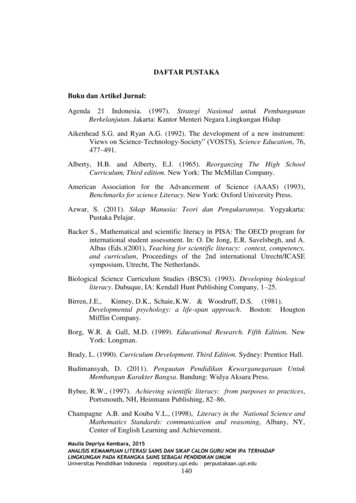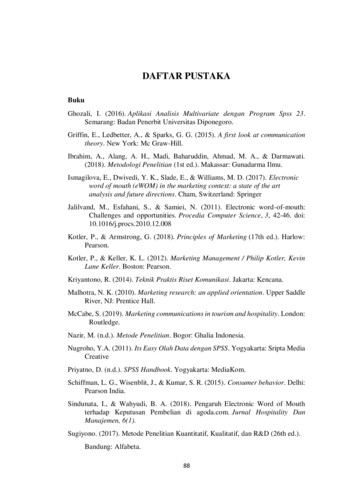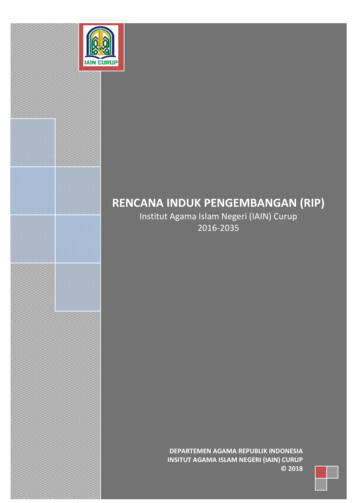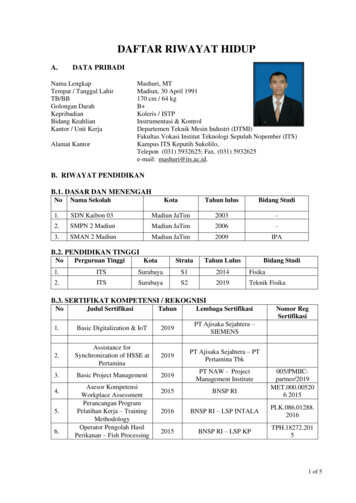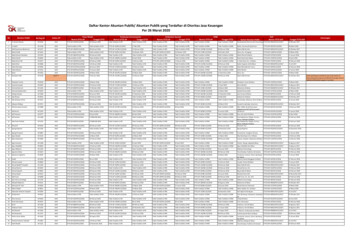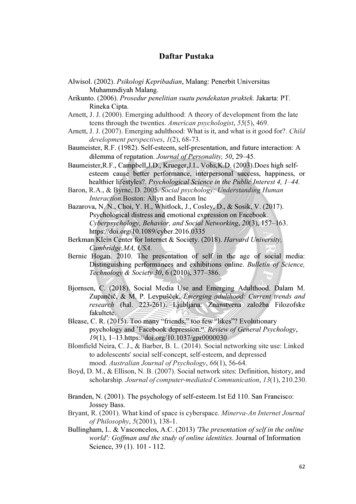
Transcription
Daftar PustakaAlwisol. (2002). Psikologi Kepribadian, Malang: Penerbit UniversitasMuhammdiyah Malang.Arikunto. (2006). Prosedur penelitian suatu pendekatan praktek. Jakarta: PT.Rineka Cipta.Arnett, J. J. (2000). Emerging adulthood: A theory of development from the lateteens through the twenties. American psychologist, 55(5), 469.Arnett, J. J. (2007). Emerging adulthood: What is it, and what is it good for?. Childdevelopment perspectives, 1(2), 68-73.Baumeister, R.F. (1982). Self-esteem, self-presentation, and future interaction: Adilemma of reputation. Journal of Personality, 50, 29–45.Baumeister,R.F., Campbell,J.D., Krueger,J.I., Vohs,K.D. (2003).Does high selfesteem cause better performance, interpersonal success, happiness, orhealthier lifestyles?. Psychological Science in the Public Interest 4, 1–44.Baron, R.A., & Byrne, D. 2005. Social psychology: Understanding HumanInteraction.Boston: Allyn and Bacon IncBazarova, N. N., Choi, Y. H., Whitlock, J., Cosley, D., & Sosik, V. (2017).Psychological distress and emotional expression on Facebook.Cyberpsychology, Behavior, and Social Networking, 20(3), erkman Klein Center for Internet & Society. (2018). Harvard University,Cambridge,MA, USA.Bernie Hogan. 2010. The presentation of self in the age of social media:Distinguishing performances and exhibitions online. Bulletin of Science,Technology & Society 30, 6 (2010), 377–386.Bjornsen, C. (2018). Social Media Use and Emerging Adulthood. Dalam M.Zupančič, & M. P. Levpušček, Emerging adulthood: Current trends andresearch (hal. 223-261). Ljubljana: Znanstvena založba Filozofskefakultete.Blease, C. R. (2015). Too many “friends,” too few “likes”? Evolutionarypsychology and ’Facebook depression.“. Review of General Psychology,19(1), 1–13.https://doi.org/10.1037/gpr0000030Blomfield Neira, C. J., & Barber, B. L. (2014). Social networking site use: Linkedto adolescents' social self-concept, self-esteem, and depressedmood. Australian Journal of Psychology, 66(1), 56-64.Boyd, D. M., & Ellison, N. B. (2007). Social network sites: Definition, history, andscholarship. Journal of computer-mediated Communication, 13(1), 210.230.Branden, N. (2001). The psychology of self-esteem.1st Ed 110. San Francisco:Jossey Bass.Bryant, R. (2001). What kind of space is cyberspace. Minerva-An Internet Journalof Philosophy, 5(2001), 138-1.Bullingham, L. & Vasconcelos, A.C. (2013) 'The presentation of self in the onlineworld': Goffman and the study of online identities. Journal of InformationScience, 39 (1). 101 - 112.62
Buss, A. H. & Briggs, S. R. (1984). Drama and the self in social interaction. Journalof Personality and Social Psychology, 47, 1310-1324.Carver, C. S., & Scheier, M. F. (1985). Aspects of self, and the control of behavior.In B. R. Schlenker (Ed.), The self and social life (pp. 146-174). New York:McGraw-Hill.Cheung, T. T. (2014). A study on motives, usage, self-presentation and number offollowers on instagram.Chou, H. T. G., & Edge, N. (2012). “They are happier and having better lives thanI am”: the impact of using Facebook on perceptions of others'lives. Cyberpsychology, Behavior, and Social Networking, 15(2), 117-121.Cooley, C. H. (1902). Looking-glass self. In The production of reality: Essays andreadings on social interaction. pp. 6.Coopersmith, S. (1967). The antecedents of self- esteem. San Francisco, CA:Freeman.DeHart, T., Pelham, B. W., & Tennen, H. (2006). What lies beneath: Parenting styleand implicit self-esteem. Journal of experimental socialpsychology, 42(1),1.17.DeLamater, J. D., & Myers, D. J. (2007). Social psychology: sixth edition.Belmonth:Thomson Wadsworth.DePaulo, B. M., Kashy, D. A., Kirkendol, S. E., Wyer, M. M., & Epstein, J. A.(1996). Lying in everyday life. Journal of Personality and SocialPsychology, 70, 979-995.Dewar, S., Islam, S., Resor, E., & Salehi, N. (2019, April). Finsta: Creating" Fake"Spaces for Authentic Performance. In Extended Abstracts of the 2019 CHIConference on Human Factors in Computing Systems (p. LBW1214). ACMEbert, H., & Piwinger, M. (2007). Impression Management: Die Notwendigkeit derSelbstdarstellung. In Handbuch Unternehmenskommunikation (pp. 205225). Gabler Verlag, Wiesbaden.Ellison, N., Heino, R., & Gibbs, J. (2006). Managing impressions online: Selfpresentation processes in the online dating environment. Journal ofcomputer mediated communication, 11(2), 415-441.Else-Quest, N. M., Higgins, A., Allison, C., & Morton, L. C. (2012). Genderdifferences in self-conscious emotional experience: A metaanalysis. Psychological bulletin, 138(5), 947.Ermanza, G.H. (2008). Hubungan harga diri dan citra tubuh pada remaja putri yangobesitas dari sosok menengah atas. Universitas Indonesia (Diakses padatanggal 10 September 2012).Gardner, H., & Davis, K. (2013). The app generation: How today's youth navigateidentity, intimacy, and imagination in a digital world. New Haven, CT: YaleUniversity Press.Goffman, E. (1959). The Presentation of Self in Everyday Life. New York:Doubleday AnchorGoffman, E. (1967). Interaction ritual: Essays on face-to-face interaction. Oxford:Aldine.Gollwitzer, P. M. (1986). Striving for specific identities: The social reality of selfsymbolizing. In R. F. Baumeister (Ed.), Public self and private life (pp. 14363
159). New York: Springer-Verlag.Gravetter, F.J & Forzano, L.B. (2009). Statistic in Behavioural Science. LosAngeles:Sage PublicationsHariyanti, D. (2011). Remaja, 64 Persen Pengguna Jejaring Sosial . Jurnas.com.Harter, S. (2012). The construction of the self: Developmental and socioculturalfoundations (2nd ed.). New York, NY: The Guilford Press.Heatherton, T.F. & Wyland, C. (2003) Assessing self-esteem. In S. Lopez and R.Snyder, (Eds).Assessing Positive Psychology. (pp. 219–233). Washington,DC: APAHogan, R., & Briggs, S. R. (1986). A socioanalytic interpretation of the public andthe private selves. In R. F. Baumeister (Ed.), Public self and private life (pp.179- 188). New York: Springer-Verlag.Hogg, M. A., & Vaughan, G. M. (2002). Social Psychology (3rd ed.). London:Prentice Hall.Hootsuite. (2018). “Indonesia Digital Landscape: A Snapshot Of the Country’s KeyDigital Statistical Indicators”. https://digitalreport.wearesocial.com/(diakses Januari 2019)Hu, Y., Manikonda, L., & Kambhampati, S. (2014). What we instagram: Afirstanalysis of instagram photo content and user types. Proceedings of AAAIConference on Weblogs and Social Media, 595–598.Ismail, N. A. H., & Tekke, M. (2015). Rediscovering Rogers’s self theory andpersonality. Journal of Educational, Health, and CommunityPsychology, 4(3),143-150.James, W. (1910). Psychology: The briefer course. New York: Holt.Jones, E. E. (1990). Interpersonal perception. New York: W.H. Freeman and Co.Kementerian Komunikasi dan Informasi RI. (2018). Penetrasi & PerilakuPengguna Internet. www.kominfo.go.id (diunduh Januari 2019).Kang, J., & Wei, L. (2018). Let me be at my funniest: Instagram using users’motivations for Finsta (a.k.a., fake Instagram). The Social Science Journal,1-10. doi:10.1016/j.soscij.2018.12.005Leary, M. R., & Kowalski, R. M. (1990). Impression management: A literaturereview and two-component model. Psychological bulletin, 107(1), 34.Leary, M. R., Nezlek, J. B., Downs, D., Radford-Davenport, J., Martin, J., &McMullen, A. (1994). Self-presentation in everyday interactions: Effects oftarget familiarity and gender composition. Journal of Personality and SocialPsychology, 67, 664-673.Lin, L. Y., Sidani, J. E., Shensa, A., Radovic, A., Miller, E., Colditz, J. B., Primack,B. A. (2016). Association between social media use and depression amongU.S. young adults. Depression and Anxiety, 33(4), 323–331.https://doi.org/10.1002/da.22466Lopez, S. J.; Snyder, C. R. (2003). Positive psychological assessment: A handbookof models and measures. Washington, DC: American PsychologicalAssociationLup, K., Trub, L., & Rosenthal, L. (2015). Instagram# instasad?: exploringassociations among instagram use, depressive symptoms, negative socialcomparison, and strangers followed. Cyberpsychology, Behavior, and64
Social Networking, 18(5), 247-252.Maheswari, J., & Dwiutami, L. (2013). Pola Perilaku Dewasa Muda YangKecenderungan Kecanduan Situs Jejaring Sosial. JPPP-Jurnal Penelitiandan Pengukuran Psikologi, 2(1), 51-62.Markus, H., & Nurius, P. (1986). Possible selves. American Psychologist, 41(9),954.Marlina, R. D. (2017). Hubungan antara fear of missing out (FOMO) dengankecenderungan kecanduan internet pada emerging adulthood. (Doctoraldissertation, Universitas Mercu Buana Yogyakarta).Marwick, A. E., & Boyd, D. (2010). I tweet honestly, I tweet passionately: Twitterusers, context collapse, and the imagined audience. New Media & Society,13(1), 114-133. doi:10.1177/1461444810365313Maslow, A. H. (2013). Toward a psychology of being. Simon and Schuster.McArthur, L. Z., & Baron, R. M. (1983). Toward an ecological theory of socialperception. Psychological Review, 90, 215-238.McGregor, K. A., & Li, J. (2019). Fake instagrams for real conversation: A thematicanalysis of the hidden social media life of teenagers. Journal of AdolescentHealth, 1-2.McManus, F., Waite, P., & Shafran, R. (2009). Cognitive-behavior therapy for lowself-esteem: a case example. Cognitive and Behavioral Practice, 16(3),266-275.Mehdizadeh, S. (2010). Self-presentation 2.0: Narcissism and self-esteem onFacebook. Cyberpsychology, behavior, and social networking, 13(4), 357364.Miller, H. (1995, June). The presentation of self in electronic life: Goffman on theInternet. In Embodied knowledge and virtual space conference (Vol. 9).Molina, B. (2017). Does your kid have a ‘finsta’ account? Why it’s a big story/tech/talkingtech/2017/10/20/does- 4001/Mruk, C. J. (2006). Changing self-esteem: Research and practice. Self-esteem issuesand answers: A sourcebook of current perspectives, 164-169.Neira, C.J.B. & Barber, B.L. 2014. Social networking site use: linked to adolescentssocial self concept, self-esteem, and depressed mood. Australian Journal ofPsychology 2014; 66: 56–64 doi: 10.1111/ajpy.12034Nie, J., & Sundar, S. S. (2013, September). Who would pay for Facebook? Selfesteem as a predictor of user behavior, identity construction and valuationof virtual possessions. In IFIP Conference on Human-ComputerInteraction (pp. 726-743). Springer, Berlin, Heidelberg.Nurgiyantoro, B., Gunawan, & Marzuki. (2004). Statistik terapan untuk penelitianilmu-ilmu sosial. Yogyakarta: Gadjah mada university press.Orso, A. (2017). Finsta: Fake Instagram. Inquerir Philadelphia. palia, D. E., Olds, S. W., & Feldman, R. D. (2007). Human development.McGraw Hill.65
Papacharissi, Z. (Ed.). (2010). A networked self: Identity, community, and cultureon social network sites. Routledge.Patterson, D. (2016). What the Finsta? The darker world of teenagers gtonpost.com/entry/what-the-finsta-the-darker- worldof-teenagers-and us 57eb9e03e4b07f20daa0fefbPickhardt, C. E. (2010, September 6). Adolescence and Self-Esteem. Pittman, M., & Reich, B. (2016). Social media and loneliness: Why an Instagrampicture may be worth more than a thousand Twitter words. Computers inHuman Behavior, 62, 155–167. https://doi.org/10.1016/j. chb.2016.03.084Pounders, K., Kowalczyk, C. M., & Stowers, K. (2016). Insight into the motivationselfie postings: Impression management and self-esteem. European Journalof Marketing, 50, 1879–1892.Purwanto, N. (2008). Metodologi Penelitian Kuantitatif. Yogyakarta: PustakaPelajar.Robins, R. W., Hendin, H. M., & Trzesniewski, K. H. (2001). Measuring globalself esteem: Construct validation of a single-item measure and theRosenberg Self Esteem Scale. Personality and social psychologybulletin, 27(2), 151-161.Rosenberg, M. (1965). Society and the adolescent self-image. Princeton, NJ:Princeton University Press.Rosenberg, M. (1979). Conceiving the self. New York: Basic Books.Rozika, L. A., & Ramdhani, N. (2016). Hubungan antara Harga Diri dan BodyImage dengan Online Self-Presentation pada Pengguna Instagram. GadjahMada Journal of Psychology (GamaJoP), 2(3), 172-183.Safronova V. (2015) On fake Instagram, a chance to be real. Diambil kembali tagram-finstagram- fakeaccount.html.Salim, F., Rahardjo, W., Tanaya, T., & Qurani, R. (2017). Are self-presentation ofinstagram users influenced by friendship-contingent self-esteem and fear ofmissing out. Makara Hubs Asia, 21, 70-82.Salimkhan, G., Manago, A. M., & Greenfield, P. M. (2010). The construction ofthe virtual self on MySpace. Cyberpsychology: Journal of PsychosocialResearch on Cyberspace, 4(1).Santrock, J.W. (2003). Adolescence: Perkembangan remaja. Jakarta: ErlanggaSantrock, J. W. (2009). Life-span development (12th ed.). New York: McGrawHill.Santrock, J. W. (2012). Life span development: Perkembangan masa hidup jilid 1.Jakarta: Erlangga.Sarandria. (2012). Efektifitas Cognitive Behavioural Therapy (CBT) UntukMeningkatkan Self esteem pada Dewasa Muda. Universitas Indonesia.Schlenker, B.R. (1980). Impression management: The self-concept, social identity,66
and interpersonal relations. Monterey, CA: Brooks/Cole.Schlenker, B. R., & Weigold, M. F. (1990). Self-consciousness and selfpresentation:Being autonomous versus appearing autonomous. Journal ofPersonality and Social Psychology, 59, 820-828.Schlenker, B. R., & Weigold, M. F. (1992). Interpersonal processes involvingimpression regulation and management. Annual review ofpsychology, 43(1), 133-168.Sheldon, P., & Bryant, K. (2016). Instagram: Motives for its use and relationship tonarcissism and contextual age. Computers in Human Behavior, 58, 89-97.Sigelman, C. K., & Rider, E. A. (2014). Life-span human development. CengageLearning.Smahel, D. (2003). Psychologie a Internet: Deti dospelymi, dospeli detmi.(Psychology and Internet: Children being adults, adults being children.).Praha: Triton.Smock, A. (2010). Self-presentation on Facebook: Managing content createdby the users and oth- ers. Paper presented at the annual conference of theInternational Communication Association, Singapore.Statista. (2019). Leading countries based on number of Instagram users as ofOctober 2019. Dipetik November 25, 2019, dari 4/countries-with-most-instagramusers/Sugiyono. (2012). Statistic untuk penelitian. Bandung: AlfabetaSwann, W. B., Jr. (1990). To be adored or to be known? The interplay of selfenhancement and self-verification. In R. M. Sorrentino & E. T. Higgins(Eds.), Motivation and cognition (Vol. 2, pp. 408-448). New York: GuilfordPress.Tedeschi, J. T. (Ed.). (2013). Impression management theory andsocial psychological research. Academic Press.Tice, D. M. (1992). Self-concept change and self-presentation: The looking glassself is also a magnifying glass. Journal of Personality and Social Psychology,63, 435-451.Tiggemann, M., & Zaccardo, M. (2016). ‘Strong is the new skinny’: A contentanalysis of #fitspiration images on Instagram. Journal of HealthPsychology, 1–9.Valkenburg, P., Schouten, A. & Peter, J. (2005). Adolescents’identity experiments on the Internet. New Media and Society, 7, 383-402.Valkenburg, P. M., Peter, J., & Schouten, A. P. (2006). Friend networking sites andtheir relationship to adolescents' well-being and social selfesteem. CyberPsychology & Behavior, 9(5), 584-590.Varnali, K., & Toker, A. (2015). Self-disclosure on social networking sites. SocialBehavior and Personality: an international journal, 43(1), 1-13.Vitak, J., Blasiola, S., Patil, S., & Litt, E. (2015). Balancing audience and privacytensions on social network sites: Strategies of highly engaged users.International Journal of Communication, 9, 1485–1504.Walther, J. B. (1996). Computer-mediated communication: Impersonal,interpersonal and hyperpersonal interaction. Communication Research, 23,67
3–43.Waterloo, S. F., Baumgartner, S. E., Peter, J., & Valkenburg, P. M. (2018). Normsof online expressions of emotion: Comparing Facebook, Twitter, Instagram,and WhatsApp. New Media & Society, 20(5), 1813–1831.Widiantari,K.S & Herdiyanto, Y.K.,. (2013). Perbedaan intensitas komunikasimelalui jejaring sosial anatara tipe kepribadian ekstrovert dan introvert padaremajaWiridjati, W., & Roesman, R. R. (2018). Fenomena Penggunaan Media Sosial DanPengaruh Teman Sebaya Pada Generasi Milenial Terhadap KeputusanPembelian. Jurnal Manajemen dan Pemasaran Jasa, 11(2), 275-290.Xuan Zhao, Niloufar Salehi, Sasha Naranjit, Sara Alwaalan, Stephen Voida, andDan Cosley. 2013. The many faces of Facebook: Experiencing social mediaas performance, exhibition, and personal archive. In Proceedings of theSIGCHI conference on human factors in computing systems. ACM, 1–10.Yang, C. C., & Brown, B. B. (2016). Online self-presentation on Facebook and selfdevelopment during the college transition. Journal of youth andadolescence, 45(2), 402-416.Yang, C. C., Holden, S. M., & Carter, M. D. (2017). Emerging adults' social mediaself-presentation and identity development at college transition:Mindfulness as a moderator. Journal of Applied DevelopmentalPsychology, 52, 212-221.Zeigler-Hill, V., & Myers, E. M. (2012). A review of gender differences in selfesteem.68
Bulletin of Science, Technology & Society 30, 6 (2010), 377-386. . Conference on Human Factors in Computing Systems (p. LBW1214). ACM Ebert, H., & Piwinger, M. (2007). Impression Management: Die Notwendigkeit der . Hubungan antara Harga Diri dan Body Image dengan Online Self-Presentation pada Pengguna Instagram. Gadjah Mada Journal of .
